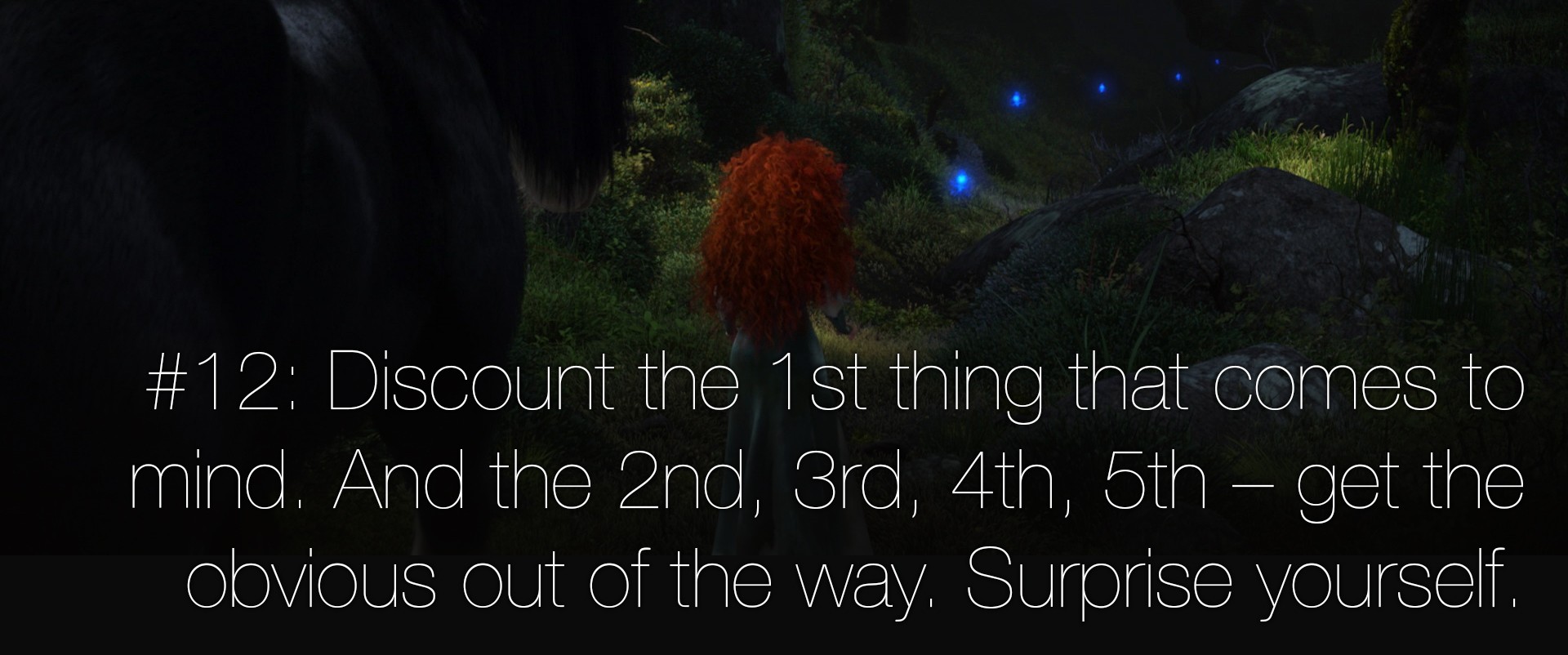A couple of years ago, then Pixar storyboard artist Emily Coats tweeted pieces of advice on making stories that she had picked up from working with Pixar, which were later compiled in several places on the internet, such as this io9 post. Later, Dino Ignacio created image macros of the individual rules which I am using in these posts.
Rule #12: “Discount the 1st thing that comes to mind. And the 2nd, 3rd, 4th, 5th – get the obvious out of the way. Surprise yourself.”
John Cleese once gave a great lecture on creativity, one portion of which in particular is pertinent to this rule (skip to ~18:16 in the video for the part I’m quoting; there’s a transcript here if that video gets taken down):
Well, let me tell you a story. I was always intrigued that one of my Monty Python colleagues who seemed to be (to me) more talented than I was {but} did never produce scripts as original as mine. And I watched for some time and then I began to see why. If he was faced with a problem, and fairly soon saw a solution, he was inclined to take it. Even though (I think) he knew the solution was not very original.
Whereas if I was in the same situation, although I was sorely tempted to take the easy way out, and finish by 5 o’clock, I just couldn’t. I’d sit there with the problem for another hour-and-a-quarter, and by sticking at it would, in the end, almost always come up with something more original.
The first solution you come up with when faced by a problem is likely to be very conventional. Imagine you need to get your money-grubbing group of players into an ancient ruin so they can stumble on some important clue about the plot or the world. The first solution that pops into your head might be “Tell them a rumor that there’s a bunch of treasure in the ruin.” If you keep thinking past that, you might also think “Have someone pay them to retrieve something from the ruin or kill a dangerous monster inside,” or “Kidnappers are hiding out in the ruins and someone is willing to pay you a lot of money to rescue their child.” These are all obvious solutions, ones you may well have already used some variation of if your game has been running for any length of time. Or else your players may have already sat through similar hooks in previous games and they’re getting bored with the same old problems.
If you allow yourself to keep playing with the problem, however, you can come up with something a little more original. Maybe a friend of one of the PC’s who owes them money disappeared while exploring the ruins. Maybe the ruins stand at one entrance to an old tunnel system that could cut days off their journey, allowing them to beat a competitor to a contract. Or perhaps the ruins are inhabited by a ghost with gold coins for eyes that’s been haunting the dreams of everyone in the nearby village, and no one there will accept the PC’s old coins (looted from another dungeon) for fear of drawing the ghost’s curse unless they exorcise the spirit first.
This is not to say that conventionality is always bad. Well-worn tropes are useful shortcuts and time savers that can give you more space to come up with creative solutions for more important problems. Some problems you are faced with are so minor that no one will notice if you go with the formulaic solution and you’ll get precious little appreciation for a truly original take. Just be aware that what is noticeable and what isn’t can shift over time. A group of players that’s normally content to swallow whatever plot hook you throw at them can become restive if you keep tossing the same ones over and over again. If you at least remain conscious enough of what you’re doing to ensure that every choice between taking the formulaic or devising an original is a deliberate one, you can keep yourself from running on autopilot.





